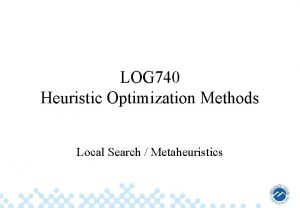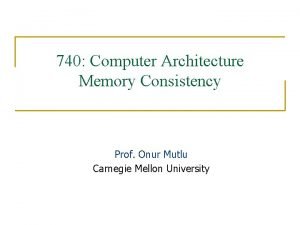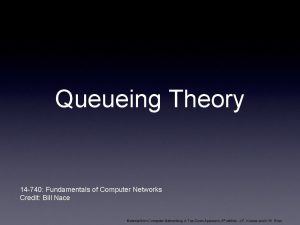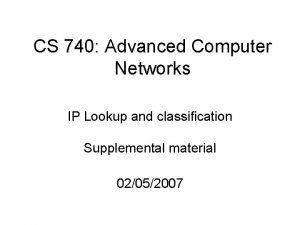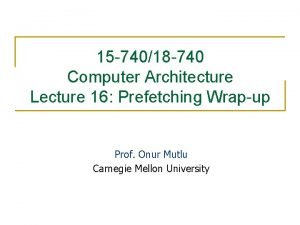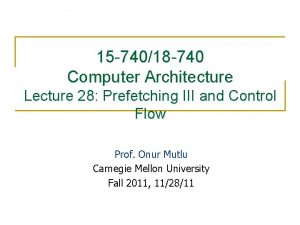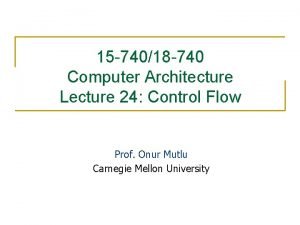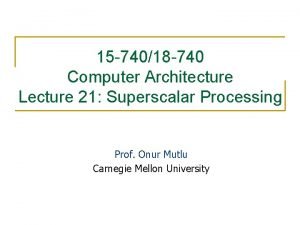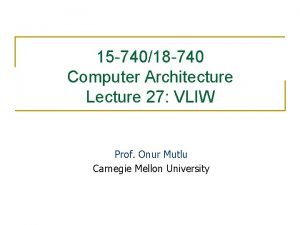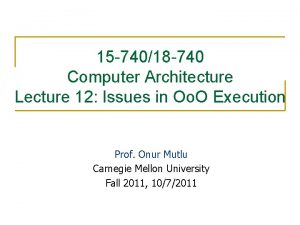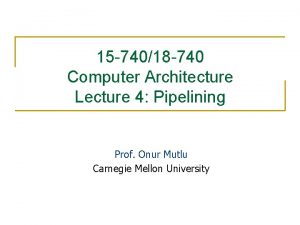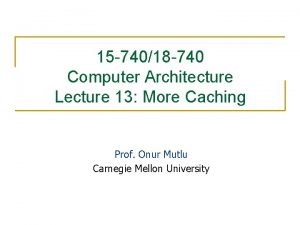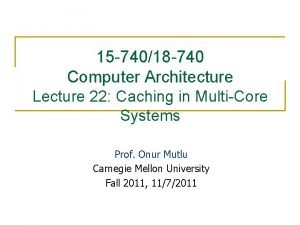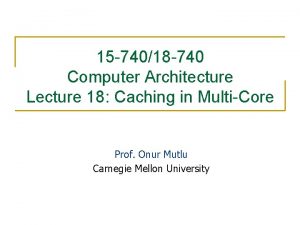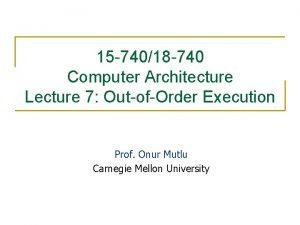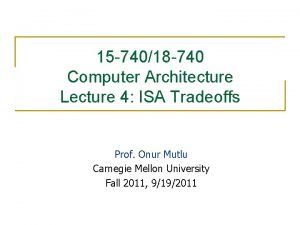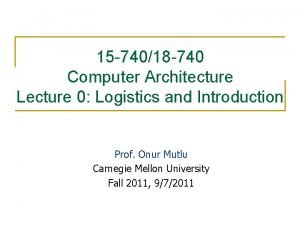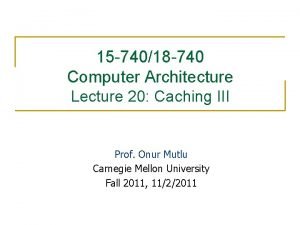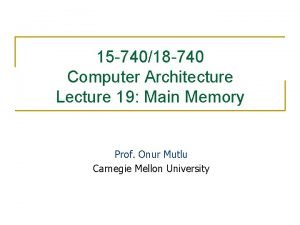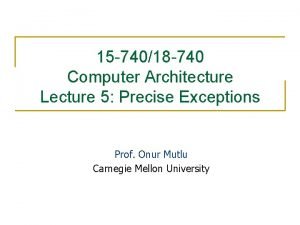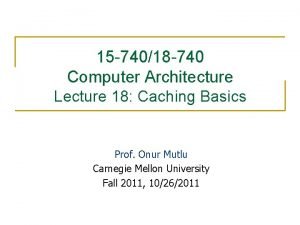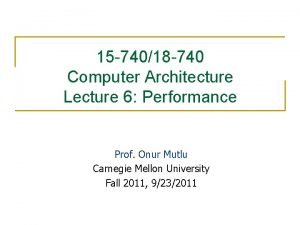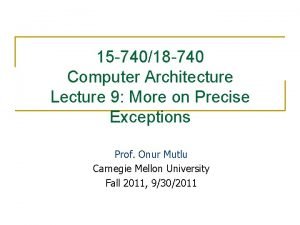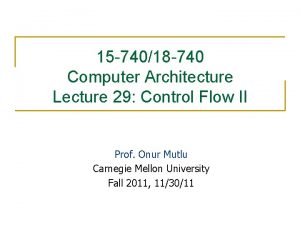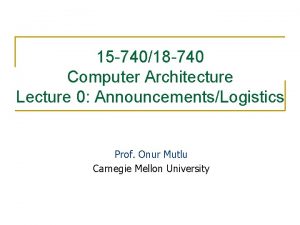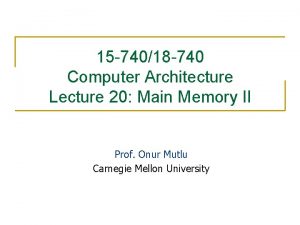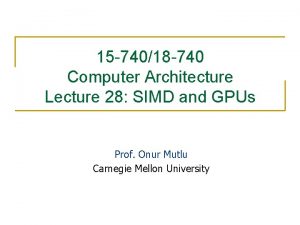15 74018 740 Computer Architecture Lecture 17 Prefetching




































- Slides: 36

15 -740/18 -740 Computer Architecture Lecture 17: Prefetching, Caching, Multi -core Prof. Onur Mutlu Carnegie Mellon University

Announcements n Milestone meetings q q Meet with Evangelos, Lavanya, Vivek And, me… especially if you receive(d) my feedback and I asked to meet 2

Last Time n n n Markov Prefetching Content Directed Prefetching Execution Based Prefetchers 3

Multi-Core Issues in Prefetching and Caching 4

Prefetching in Multi-Core (I) n Prefetching shared data q n Coherence misses Prefetch efficiency a lot more important q q Bus bandwidth more precious Prefetchers on different cores can deny service to each other and to demand requests n n n q DRAM contention Bus contention Cache conflicts Need to coordinate the actions of independent prefetchers for best system performance n Each prefetcher has different accuracy, coverage, timeliness 5

Shortcoming of Local Prefetcher Throttling Core 0 Core 1 Prefetcher 4 Degree: 2 Prefetcher Degree: 4 2 FDP Throttle Up Core 2 Core 3 FDP Throttle Up Shared Cache Set 0 Used_P Dem Pref 02 Dem Pref 13 Dem 2 Dem 3 Set 1 Used_P Dem 03 Used_P Pref Dem 03 Pref Dem 12 Dem Pref 12 Dem 3 Set 2 Pref Dem 02 Pref Dem 13 Dem 02 Pref Dem 3 … … Local-only prefetcher control techniques have no mechanism to detect inter-core interference 6

Prefetching in Multi-Core (II) n Ideas for coordinating different prefetchers’ actions q Utility-based prioritization n q Cost-benefit analysis n q Prioritize prefetchers that provide the best marginal utility on system performance Compute cost-benefit of each prefetcher to drive prioritization Heuristic based methods n n Global controller overrides local controller’s throttling decision based on interference and accuracy of prefetchers Ebrahimi et al. , “Coordinated Management of Multiple Prefetchers in Multi-Core Systems, ” MICRO 2009. 7

Hierarchical Prefetcher Throttling Global Control: goal: accepts or Local control’s Maximize the overrides decisions made by prefetching local controlperformance to improve of core i independently overall system performance Final Throttling Decision Pref. i Throttling Decision Local Control Global control’s goal: Keep track. Memory of and. Controller control prefetchercaused inter-core interference in shared memory system Accuracy Local Core i Throttling Decision Bandwidth Feedback Global Control Cache Pollution Feedback Shared Cache 8

Hierarchical Prefetcher Throttling Example - High accuracy - High pollution - High bandwidth consumed while other cores need bandwidth Pref. i Local Control Memory Controller High(i)BW (i) BW BWNO (i) High BWNO (i) Final Enforce Throttling. Down Decision Throttle Global Control High Acc (i) Local Throttling. Up Decision Core i Throttle Pol. Filter i Pol (i) High Shared Cache 9

Multi-Core Issues in Caching n Multi-core q q q n Placement/insertion q q n More pressure on the memory/cache hierarchy cache efficiency a lot more important Private versus shared caching Providing fairness/Qo. S in shared multi-core caches Migration of shared data in private caches How to organize/connect caches: n Non-uniform cache access and cache interconnect design Identifying what is most profitable to insert into cache Minimizing dead/useless blocks Replacement q Cost-aware: which block is most profitable to keep? 10

Cache Coherence n Basic question: If multiple processors cache the same block, how do they ensure they all see a consistent state? P 2 P 1 Interconnection Network x 1000 Main Memory 11

The Cache Coherence Problem P 2 P 1 ld r 2, x 1000 Interconnection Network x 1000 Main Memory 12

The Cache Coherence Problem ld r 2, x P 1 P 2 1000 ld r 2, x Interconnection Network x 1000 Main Memory 13

The Cache Coherence Problem ld r 2, x add r 1, r 2, r 4 st x, r 1 P 2 2000 1000 ld r 2, x Interconnection Network x 1000 Main Memory 14

The Cache Coherence Problem ld r 2, x add r 1, r 2, r 4 st x, r 1 P 2 2000 1000 ld r 2, x Should NOT load 1000 ld r 5, x Interconnection Network x 1000 Main Memory 15

Cache Coherence: Whose Responsibility? n Software q q Can the programmer ensure coherence if caches are invisible to software? What if the ISA provided the following instruction? n n q What if the ISA provided the following instruction? n n n FLUSH-LOCAL A: Flushes/invalidates the cache block containing address A from a processor’s local cache When does the programmer need to FLUSH-LOCAL an address? FLUSH-GLOBAL A: Flushes/invalidates the cache block containing address A from all other processors’ caches When does the programmer need to FLUSH-GLOBAL an address? Hardware q q Simplifies software’s job One idea: Invalidate all other copies of block A when a processor writes to it 16

Snoopy Cache Coherence n n Caches “snoop” (observe) each other’s write/read operations A simple protocol: Pr. Rd/-- Pr. Wr / Bus. Wr Valid n Bus. Wr Pr. Rd / Bus. Rd n Write-through, nowrite-allocate cache Actions: Pr. Rd, Pr. Wr, Bus. Rd, Bus. Wr Invalid Pr. Wr / Bus. Wr 17

Multi-core Issues in Caching n n n How does the cache hierarchy change in a multi-core system? Private cache: Cache belongs to one core Shared cache: Cache is shared by multiple cores CORE 0 CORE 1 CORE 2 CORE 3 L 2 CACHE DRAM MEMORY CONTROLLER CORE 0 CORE 1 CORE 2 CORE 3 L 2 CACHE DRAM MEMORY CONTROLLER 18

Shared Caches Between Cores n Advantages: q Dynamic partitioning of available cache space n q q n No fragmentation due to static partitioning Easier to maintain coherence Shared data and locks do not ping pong between caches Disadvantages q Cores incur conflict misses due to other cores’ accesses n n Misses due to inter-core interference Some cores can destroy the hit rate of other cores q q q What kind of access patterns could cause this? Guaranteeing a minimum level of service (or fairness) to each core is harder (how much space, how much bandwidth? ) High bandwidth harder to obtain (N cores N ports? ) 19

Shared Caches: How to Share? n Free-for-all sharing q q q n Placement/replacement policies are the same as a single core system (usually LRU or pseudo-LRU) Not thread/application aware An incoming block evicts a block regardless of which threads the blocks belong to Problems q q q A cache-unfriendly application can destroy the performance of a cache friendly application Not all applications benefit equally from the same amount of cache: free-for-all might prioritize those that do not benefit Reduced performance, reduced fairness 20

Problem with Shared Caches Processor Core 1 ←t 1 Processor Core 2 L 1 $ L 2 $ …… 21

Problem with Shared Caches t 2→ Processor Core 1 L 1 $ Processor Core 2 L 1 $ L 2 $ …… 22

Problem with Shared Caches Processor Core 1 ←t 1 t 2→ L 1 $ Processor Core 2 L 1 $ L 2 $ …… t 2’s throughput is significantly reduced due to unfair cache sharing. 23

Controlled Cache Sharing n Utility based cache partitioning q q n Fair cache partitioning q n Qureshi and Patt, “Utility-Based Cache Partitioning: A Low-Overhead, High. Performance, Runtime Mechanism to Partition Shared Caches, ” MICRO 2006. Suh et al. , “A New Memory Monitoring Scheme for Memory-Aware Scheduling and Partitioning, ” HPCA 2002. Kim et al. , “Fair Cache Sharing and Partitioning in a Chip Multiprocessor Architecture, ” PACT 2004. Shared/private mixed cache mechanisms q q Qureshi, “Adaptive Spill-Receive for Robust High-Performance Caching in CMPs, ” HPCA 2009. Hardavellas et al. , “Reactive NUCA: Near-Optimal Block Placement and Replication in Distributed Caches, ” ISCA 2009. 24

Utility Based Shared Cache Goal: Maximize system throughput Partitioning n n n Observation: Not all threads/applications benefit equally from caching simple LRU replacement not good for system throughput Idea: Allocate more cache space to applications that obtain the most benefit from more space The high-level idea can be applied to other shared resources as well. Qureshi and Patt, “Utility-Based Cache Partitioning: A Low. Overhead, High-Performance, Runtime Mechanism to Partition Shared Caches, ” MICRO 2006. Suh et al. , “A New Memory Monitoring Scheme for Memory. Aware Scheduling and Partitioning, ” HPCA 2002. 25

Utility Based Cache Partitioning (I) Misses per 1000 instructions Utility Uab = Misses with a ways – Misses with b ways Low Utility High Utility Saturating Utility Num ways from 16 -way 1 MB L 2 26

Misses per 1000 instructions (MPKI) Utility Based Cache Partitioning (II) equake vpr UTIL LRU Idea: Give more cache to the application that benefits more from cache 27

Utility Based Cache Partitioning (III) UMON 1 I$ Core 1 D$ PA UMON 2 Shared L 2 cache I$ Core 2 D$ Main Memory Three components: q Utility Monitors (UMON) per core q Partitioning Algorithm (PA) q Replacement support to enforce partitions 28

Utility Monitors q For each core, simulate LRU using auxiliary tag store (ATS) q Hit counters in ATS to count hits per recency position q LRU is a stack algorithm: hit counts utility E. g. hits(2 ways) = H 0+H 1 (MRU)H 0 H 1 H 2…H 15(LRU) MTS Set A Set B Set C Set D Set E Set F Set G Set H +++ + ATS Set A Set B Set C Set D Set E Set F Set G Set H 29

Utility Monitors 30

Dynamic Set Sampling q Extra tags incur hardware and power overhead q DSS reduces overhead [Qureshi+ ISCA’ 06] q 32 sets sufficient (analytical bounds) q Storage < 2 k. B/UMON (MRU)H 0 H 1 H 2…H 15(LRU) MTD Set A Set B Set C Set D Set E Set F Set G Set H +++ + A Set B ATD Set B E C Set G Set D Set E Set F UMON Set (DSS) G Set H 31

Partitioning Algorithm q q Evaluate all possible partitions and select the best With a ways to core 1 and (16 -a) ways to core 2: Hitscore 1 = (H 0 + H 1 + … + Ha-1) ---- from UMON 1 Hitscore 2 = (H 0 + H 1 + … + H 16 -a-1) ---- from UMON 2 q Select a that maximizes (Hitscore 1 + Hitscore 2) q Partitioning done once every 5 million cycles 32

Way Partitioning Way partitioning support: 1. Each line has core-id bits 2. On a miss, count ways_occupied in set by miss-causing app ways_occupied < ways_given Yes Victim is the LRU line from other app No Victim is the LRU line from miss-causing app 33

Performance Metrics n Three metrics for performance: 1. Weighted Speedup (default metric) perf = IPC 1/Single. IPC 1 + IPC 2/Single. IPC 2 correlates with reduction in execution time 2. Throughput perf = IPC 1 + IPC 2 can be unfair to low-IPC application 3. Hmean-fairness perf = hmean(IPC 1/Single. IPC 1, IPC 2/Single. IPC 2) balances fairness and performance 34

Utility Based Cache Partitioning Performance Four cores sharing a 2 MB 32 -way L 2 LRU UCP(Greedy) UCP(Lookahead) UCP(Eval. All) Mix 1 Mix 2 (gap-applu-apsi-gzp) (swm-glg-mesa-prl) Mix 3 Mix 4 (mcf-applu-art-vrtx) (mcf-art-eqk-wupw) 35

Utility Based Cache Partitioning n Advantages over LRU + Better utilizes the shared cache n Disadvantages/Limitations - Scalability: Partitioning limited to ways. What if you have num. Ways < num. Apps? - Scalability: How is utility computed in a distributed cache? - What if past behavior is not a good predictor of utility? 36
 Data prefetching championship
Data prefetching championship Prefetching relevant priors
Prefetching relevant priors Architecture lecture notes
Architecture lecture notes Isa definition computer
Isa definition computer Asc 740
Asc 740 Fin 18 interim tax provision
Fin 18 interim tax provision Outside basis difference
Outside basis difference 740
740 Asc 740-30-25-9
Asc 740-30-25-9 740
740 Public law 740 passed by congress
Public law 740 passed by congress 14-740
14-740 F 740
F 740 Dell 740r
Dell 740r Cs 740
Cs 740 01:640:244 lecture notes - lecture 15: plat, idah, farad
01:640:244 lecture notes - lecture 15: plat, idah, farad Buses in computer architecture
Buses in computer architecture Difference between organisation and architecture
Difference between organisation and architecture Design of a basic computer
Design of a basic computer Computer security 161 cryptocurrency lecture
Computer security 161 cryptocurrency lecture Computer-aided drug design lecture notes
Computer-aided drug design lecture notes Abc in software architecture
Abc in software architecture Call and return architecture in software engineering
Call and return architecture in software engineering Integral product architecture
Integral product architecture Modular product architectures
Modular product architectures Computer organization and architecture 10th solution
Computer organization and architecture 10th solution Ocs architecture
Ocs architecture Computer organization lab experiments
Computer organization lab experiments Introduction to computer organization and architecture
Introduction to computer organization and architecture Timing and control in computer architecture
Timing and control in computer architecture Computer architecture: concepts and evolution
Computer architecture: concepts and evolution Programmed i/o in computer architecture
Programmed i/o in computer architecture Fp adder
Fp adder Absolute addressing mode
Absolute addressing mode Static interconnection network in computer architecture
Static interconnection network in computer architecture Smt computer architecture
Smt computer architecture Pseudo
Pseudo







